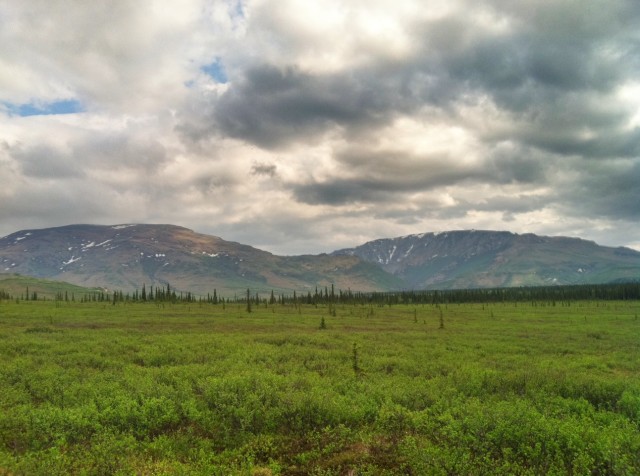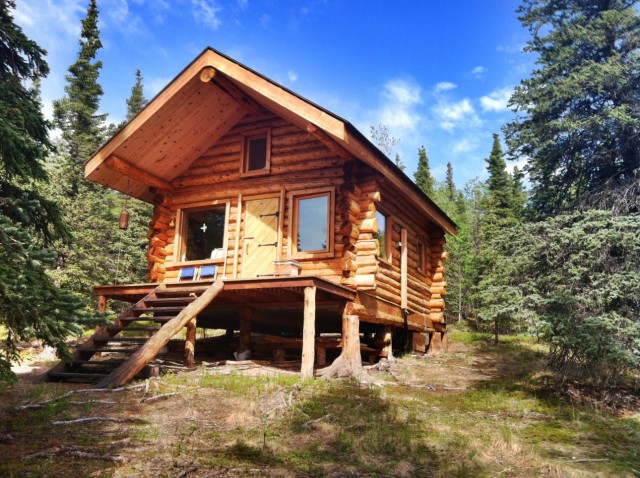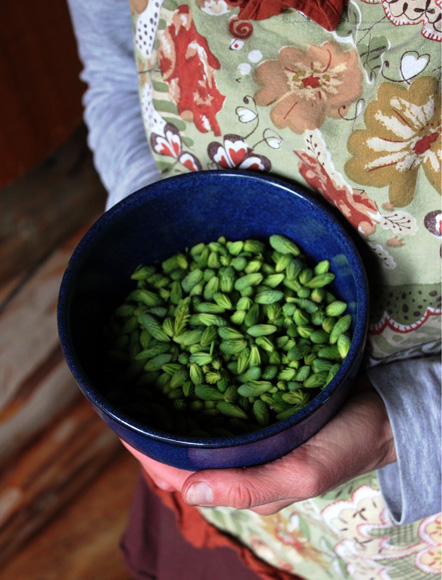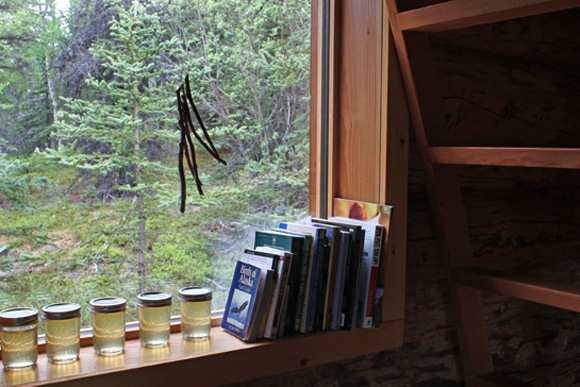For in the true nature of things, if we rightly consider,
every green tree is far more glorious than if it were made of gold and silver.
~Martin Luther
 Our cabin in Alaska sits at the base of a ridge overlooking a vast stretch of taiga. We always say that we are “going down to the tundra,” even though that’s not technically correct. The two habitats are similar, but taiga is warmer and wetter than tundra, and it is capable of supporting a small number of evergreen trees — in our case, white spruce.
Our cabin in Alaska sits at the base of a ridge overlooking a vast stretch of taiga. We always say that we are “going down to the tundra,” even though that’s not technically correct. The two habitats are similar, but taiga is warmer and wetter than tundra, and it is capable of supporting a small number of evergreen trees — in our case, white spruce.
While the taiga’s trees are undersized and spindly, on the ridge around us they gather together in a rich forest, shared primarily with aspen trees and low-growing shrubs like wild roses. The cabin itself is made of white spruce logs from the surrounding land, each one carefully stripped and perfectly fitted together.
 As we were planning our recent trip to Alaska, I was of course wondering what I might find in the forest to forage or preserve so early in the season. It was my friend Nicole at Arctic Garden Studio who first suggested spruce tip jelly. (Nicole writes her beautiful blog from Fairbanks and she just posted a lovely, seasonal recipe for Spruce Tip and Rose Petal Shortbread. The rose petals are of the wild variety that are in a passionate, pink bloom all around Fairbanks right this minute.)
As we were planning our recent trip to Alaska, I was of course wondering what I might find in the forest to forage or preserve so early in the season. It was my friend Nicole at Arctic Garden Studio who first suggested spruce tip jelly. (Nicole writes her beautiful blog from Fairbanks and she just posted a lovely, seasonal recipe for Spruce Tip and Rose Petal Shortbread. The rose petals are of the wild variety that are in a passionate, pink bloom all around Fairbanks right this minute.)
I arrived at the cabin, jelly recipe in hand, ready to go — but at our latitude and elevation, here’s what the spruce tips looked like.
 They were not quite ready for the jelly-making business. However, there is one sure thing about the growing season in Alaska: When it finally happens, it happens fast. Within a week, I was picking and sorting tender, young spruce tips — which are the only kind you should use for a jelly like this. My research said it’s best to pick them when the papery covering has just fallen off. I had to help mine along a little bit, pinching away the coverings until I had three cups of clean tips. They infused the cabin with such a fresh, bright scent that everyone was drawn to put their nose into the bowl.
They were not quite ready for the jelly-making business. However, there is one sure thing about the growing season in Alaska: When it finally happens, it happens fast. Within a week, I was picking and sorting tender, young spruce tips — which are the only kind you should use for a jelly like this. My research said it’s best to pick them when the papery covering has just fallen off. I had to help mine along a little bit, pinching away the coverings until I had three cups of clean tips. They infused the cabin with such a fresh, bright scent that everyone was drawn to put their nose into the bowl.
 I found myself surprisingly aware of what I was doing as I was going from tree to tree, gathering these tips. I realized that I was taking part of the livelihood of each tree I touched — its most vulnerable new growth. It put me in mind of the word “reverence.” I was careful not to take too many tips from any one tree, not to take any tips from very small trees, and to say thank you many times. I’m often mindful when I’m picking the fruit or leaves of plants, but never have I felt in quite so much awe of my source. For example, with the wild blackberries in California, I am always grateful, but also likely to cuss and gripe about their grabby, scratchy ways. I stomp them down without much regret, knowing they’ll return with a vengeance. These great trees, on the other hand, made my heart go down on its knees.
I found myself surprisingly aware of what I was doing as I was going from tree to tree, gathering these tips. I realized that I was taking part of the livelihood of each tree I touched — its most vulnerable new growth. It put me in mind of the word “reverence.” I was careful not to take too many tips from any one tree, not to take any tips from very small trees, and to say thank you many times. I’m often mindful when I’m picking the fruit or leaves of plants, but never have I felt in quite so much awe of my source. For example, with the wild blackberries in California, I am always grateful, but also likely to cuss and gripe about their grabby, scratchy ways. I stomp them down without much regret, knowing they’ll return with a vengeance. These great trees, on the other hand, made my heart go down on its knees.
You’ll need to pick three to four cups of spruce tips to make the juice for this recipe. Because our tips were just coming in, I picked only three cups. If it had been a week later, the tips would have been more plentiful and I probably would have picked more for a slightly stronger flavor. That said, I’d be cautious about overdoing it. As is, this jelly is subtly floral with a hint of the citrusy, astringent bite of new spruce. It’s clear that using too many tips could lead to a resiny burn instead of a gentle bite. Different varieties of spruce may also lead to different results. I’d probably try three-and-a-half cups next time, to compare.
I made this jelly using a process similar to that for mint jelly, and I imagine I’ll use it in the same way I would use mint jelly. But I’m also looking forward to adding it to other preserves. Considering what grows wild around the spruce trees themselves, I’m thinking about a spruce-tip scented blueberry jam (wild blueberries are plentiful on the taiga), something with wild rose petals or rose hips, or — later in the year — a holiday mix of lingonberry and spruce. I don’t know whether I’ll actually get to any of those things, but it’s nice to dream.
Spruce Tip Jelly
3 cups spruce tip juice
4 cups sugar
1 package 
Day One: Prepare the Spruce Tip Juice
1. Rinse 3-4 cups of spruce tips in cold water. Drain and then lightly chop them.
2. Place the spruce tips in a small saucepan with 3 1/2 cups cold water. Bring to a boil and then immediately remove them from the heat.
3. Transfer the tips and liquid to a heatproof bowl, cover tightly, and let rest overnight. (It was a cool evening, so I set mine out on our back porch. I don’t think it matters much whether you leave them at room temp or refrigerate them.)
Day Two: Make Your Jelly
1. Sterilize 5 half-pint jars.
2. Collect the spruce tip juice by straining the liquid through a chinois, jelly bag, or several layers of cheesecloth. (If you use a jelly bag or cheesecloth, be sure to dunk it in scalding water first — not just to cleanse it, but to hydrate it so a dry cloth doesn’t soak up that good juice.)
3. Measure 3 cups of spruce tip juice into a 6- or 8-quart saucepot. (Use only 3 cups. Adding more could screw up your set.)
4. Measure the sugar into a separate bowl.
5. Stir the entire packet of pectin into the saucepot. (I had heard some great things about MCP pectin, so I decided to see what the fuss was about. I have to say, I was impressed. The set is fabulous — a real, smooth jelly set, not like Jell-O. Also, it dissolved nicely, without lumps. As someonewho doesn’t mind using boxed pectin in simple jellies — never marmalades — where I want an easy, reliable set, I have to say I am a new fan. If you use a different brand of pectin, be sure to follow the recipe directions in that box. I’d use the proportions given for mint jelly.)
6. Bring the mixture to a full rolling boil — that is, a boil that you can’t stir down — on high heat, stirring constantly.
7. Quickly stir in the sugar. Return the mixture to a rolling boil and boil for exactly 2 minutes, stirring constantly. Remove from heat and skim foam. (I use a large, shallow, stainless steel spoon for skimming.)
8. Ladle or pour the hot jelly into the sterilized jars, leaving 1/4-inch head space. Wipe the rims with a clean, damp cloth and secure the lids. Process in a water-bath canner, using the correct time for your altitude: 5 minutes for 0-1,000 feet above sea level, plus 1 minute for every additional 1,000 feet.
Yields about 5 half-pint jars. (If you want more than this, plan to make multiple small batches. As with most jelly recipes, doubling the batch size may mess with your set.)





